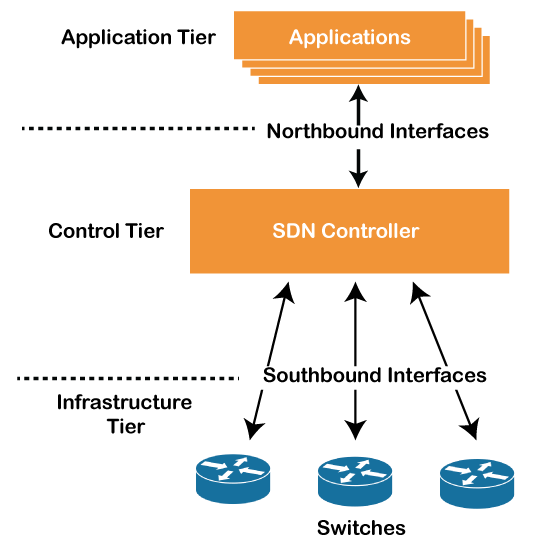Software Defined Networking (SDN): Benefits and Challenges of Network VirtualizationIntroductionSoftware-defined networking (SDN) is a new networking paradigm that separates the network's control and data planes. The traditional networking architecture has a tightly coupled relationship between the data and control planes. This means that network devices, such as routers and switches, are responsible for forwarding packets and determining how the network should operate. With SDN, the control plane is decoupled from the data plane and implemented in software, allowing for centralized network control. The control plane, also called the network controller, is responsible for making decisions about how traffic should be forwarded, based on the overall network policy. The data plane, on the other hand, is responsible for forwarding traffic based on the decisions made by the control plane. In SDN, network devices are called switches, and they are typically simple, low-cost devices that forward traffic based on the instructions received from the network controller. The controller communicates with the switches using a standard protocol, such as OpenFlow, which allows the controller to program the switches to forward traffic in a particular way. What is Data Plane?In computer networking, the data plane is the part of a network device responsible for forwarding data packets from one interface to another. It is also referred to as the forwarding plane or the user plane. The data plane operates at the lowest level of the network stack, typically at Layer 2 (the Data Link layer) and Layer 3 (the Network layer) of the OSI model. Its main responsibility is to forward packets from one interface to another based on the destination address contained in the packet header. In traditional networking, network devices such as routers and switches have a tightly coupled control plane and data plane. This means that the devices are responsible for both forwarding packets and making decisions about how the network should operate. However, in software-defined networking (SDN), the control plane is separated from the data plane, allowing for centralized control of the network. In SDN, the data plane is implemented in network devices, such as switches, and is responsible for forwarding packets based on the instructions received from the centralized control plane. This allows for greater flexibility and scalability in the network, as the data plane can be reprogrammed in real-time to accommodate changing network conditions. What is Control Plane?In computer networking, the control plane is part of a network device or system that is responsible for managing and controlling the flow of network traffic. It is responsible for making decisions about how packets are forwarded across the network based on factors such as network topology, routing protocols, and network policies. The control plane operates at a higher network stack level than the data plane, typically at Layer 3 (the Network layer) and above in the OSI model. It is responsible for routing, switching, and traffic engineering tasks. In traditional networking, the control plane and data plane are tightly coupled, meaning that network devices such as routers and switches are responsible for forwarding packets and making decisions about how the network should operate. However, in software-defined networking (SDN), the control plane is separated from the data plane, allowing for centralized network control. In SDN, the controller communicates with the network devices in the data plane using a standard protocol, such as OpenFlow, to program the devices to forward packets in a particular way. The benefits of a separate control plane in SDN include greater network flexibility and scalability, as the network policy can be changed in real-time to meet changing network conditions. It also allows for easier network management, as the network can be managed from a centralized location. SDN ArchitectureThe architecture of software-defined networking (SDN) consists of three main layers: the application layer, the control layer, and the infrastructure layer. Each layer has a specific role and interacts with the other layers to manage and control the network. 
Examples of applications that can be deployed in an SDN environment include network virtualization, traffic engineering, security, and monitoring. The application layer can be used to create customized network services that meet specific business needs. The main benefit of the SDN architecture is its flexibility and ability to centralize control of the network. The separation of the control plane from the data plane enables network administrators to configure and manage the network more easily and in a more granular way, allowing for greater network agility and faster response times to changes in network traffic. Advantages of SDN:Software-defined networking (SDN) offers several advantages over traditional networking architectures, including:
Overall, SDN offers a more flexible, programmable, and centralized approach to networking that can result in significant cost savings, enhanced network security, and improved network performance and reliability. Disadvantages of SDNWhile software-defined networking (SDN) has several advantages over traditional networking, there are also some potential disadvantages that organizations should be aware of. Here are some of the main disadvantages of SDN:
In summary, while SDN offers many benefits, organizations should carefully consider the potential drawbacks before implementing an SDN solution. A thorough evaluation of the organization's needs and existing infrastructure, as well as a comprehensive understanding of the benefits and limitations of SDN, is critical to making an informed decision. Overall, SDN is an emerging technology that has the potential to transform the way networks are designed, deployed, and managed. |
 For Videos Join Our Youtube Channel: Join Now
For Videos Join Our Youtube Channel: Join Now
Feedback
- Send your Feedback to [email protected]
Help Others, Please Share










